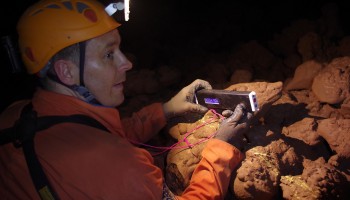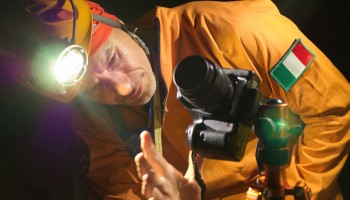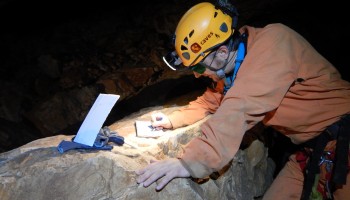[youtube GVIm_h9t9Oc]
Cave exploration is a wonderful and exciting experience. Tales of exploration are perfect for telling around a fire or for writing in books. But no description of caves can really convey the physicality of what was explored. Emotions can be retold, but this is not what scientists aim to report on. The best ways for documenting cave exploration are mapping and photography. The combination of these techniques gives a geographic significance to the exploration and delivers a great deal of useful information for science. Explored caves always have to be carefully mapped and photographs are taken of survey stations and of the most scientifically interesting (or just beautiful) places and corners, from large rooms to tiny and fragile speleothems.
Mapping operational scenario
During the CAVES mission environments and passages are surveyed using novel technology based on laser range finders and the CaveSniper instrument. The combination of these devices allows us to measure distance, direction and inclinations between survey stations. At each station it is also possible to take measurements of the surrounding environments using “splay shots”. The route from station to station coupled with splay measurements allow software (called Compass Cave) to construct a 3D model of the cave and draw a cave map (on the horizontal plane) and a profile (on the vertical plane). The result can be used by future cave explorers and scientists to locate sampling and monitoring sites. The 3D survey map can also be displayed on surface maps to chart cave development below Earth’s surface. Cavenauts take measurements of the caves and the data is processed with Compass software. This allows them to see a representation of the new cave areas they explored.
Things to keep in mind about mapping
The instruments are rugged but not waterproof. Cavenauts have to keep them clean, dry, and protected. It is important to take care to make the right measurements, and take precise field notes to allow double-checks between data and instrument records. It will save time later and avoid mistakes. Another thing to keep in mind is the danger of the laser beams for eyes. Operators must wear goggles. These issues can be easily controlled to create an efficient and fast survey team. It is important to choose suitable survey points that are easily identifiable, easy to reach and visible from the previous and the next survey points. The points should be at a representative location of the cave within reasonable distance from each other.
Photography operational scenario
Cave maps are useful and necessary but they do not hold the same information and realism as cave photographs. A proper photograph of the cave can convey some of the emotions felt by the explorers.
During CAVES, cavenauts make pictures of survey stations and cross sections, of very small things (cave animals or tiny speleothems) and very large underground spaces. They will use compact cameras for easy and quick documentary photographs, and a professional camera on tripod and several flashes or Scurion ledlights (helmets) for aestethic pictures documenting the environment. Photos are downloaded on a netbook at the Campsite every evening. Each photo will be connected in a database directly to the survey location in order to have a geographical and visual reference of every location.
Things to take in mind for photography
Making pictures in a dark world is not an easy task. Cavenauts have to make wise use of helmet lights flash photography, using imagination to set up the scene. Cave photography is similar to theater scenography: you choose what you want to show and how much light you want on the subject matter. Cave photography is teamwork, where the photographer acts as director while flash and light operators act accordingly to the chosen scene.
Note that battery energy is limited: it is really important to conserve energy. Cameras are delicate equipment so it is important to be aware of the environment and not get them wet or dirty with mud. During movement it is absolutely necessary to keep cameras in sealed containers, and have the bag in which they are stored attached to a harness to avoid falls. It can be annoying to take cameras out and return them to their containers each time, but it is worth the effort if you want to keep taking pictures during the whole exploration.
Compact cameras are easier and quicker to use: the more you pictures you take the better you document the scene, but if something more than documentation is needed, a reflex camera and tripod is recommended.
Dr. Francesco Sauro, University of Bologna, Survey and Photography instructor
Prof. Jo De Waele, University of Bologna, Survey instructor




Discussion: no comments